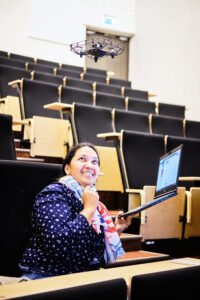To use the possibilities of technology wisely at school, you need someone who can find suitable solutions for the field of education. An educational technologist is like an interpreter between teachers and the field of technology. Diana Veskimägi, the head of the Estonian Association of Educational Technologists, believes strongly Estonian schools need many more educational technologists, the need for them has only grown.
Educational technologists – experienced teachers who have completed a master’s degree to become technology integration specialists – have been working at Estonian schools since 2005. With the crisis, their role became even more important. “It is no longer necessary to explain who these educational technologists really are,” says Diana Veskimägi, a computer science teacher and an experienced educational technologist. “And it’s not necessary to talk about why we need an educational technologist anymore.” According to Diana, also the head of the Estonian Association of Educational Technologists, there should be many more educational technologists in Estonia as well, because the need for them has only grown.

Diana, you should have a pretty good idea of how digitally aware our students are.
As adults, we often have the misconception that students know everything very well, better than we do because they are always on a smart device and a computer. But when I look at it from the perspective of an IT teacher, I see that they have no substantive skills. They have the ability to quickly scroll text or images on the screen, watch videos, chat. Communication skills seem to exist, but there are no other skills. These must be developed at school. At the corona time, the bottlenecks came to the fore.
See also:
Digital Competence: Empowering teachers and students
There are two corona period school years behind us. How do you think the students have coped?
In the spring of 2020, it was quite difficult for both students and teachers in Estonia, and the new situation required getting used to it. The more time passed, the smoother the teaching became. This academic year we could already do pretty well; by the autumn, the knowledge was acquired on an ongoing basis.
What have been the main concerns in the use of technological solutions?
In most cases, they were related to the fact that the school did not create a unified system. The biggest concern was when the student had to find each teacher’s study material in a different place, create an account in different places and log in to several places, this created confusion.
But were there enough computers in Estonian schools?
At our school (Diana works at Pärnu Vanalinna School), we rented computers for everyone who needed them. I provided all the school laptops: to 48 students and some also to teachers. We could have used some more; I initially had to give a tablet to about five people. In addition, I rented out webcams, headphones, digital boards, and other equipment.
See also:
Digital competence: teaching 21st-century skills
In general, it was technology that there were mainly problems with. Often the student has a smart device at home, but no computer. The parents usually have a computer – either a work computer or a very old desktop computer. And as the online class required a webcam, many had a problem, or the computer was so old that the student could not attend the online lesson, just were not equipped to do it. Also, there were not very good internet connections in rural areas.
How has this time affected academic performance?
After all, various studies have shown that one-third of students liked distance learning much more than going to school. It didn’t matter to a third. And a third needed help or stayed behind. If you turn this ratio to a normal situation, you will get quite the same picture. In that sense, I don’t see a crash in learning. But when it comes to academic performance – it’s completely my personal experience and opinion – those who were supported by the family coped. Not all children are able to manage themselves, and if someone kept their eye on the situation and provided support at home, it was much easier for the child to cope with the difficulties.
In the past, some students were dragged along by a teacher.
Yes. The student could have been sitting in the classroom earlier as well and staring at the ceiling. But he was there, the teacher could communicate with him. When he did not come to the online class, no one at home supported him and made sure he showed up… After all, the teacher cannot go to the home and make the child sit behind the computer.
So the extremes were basically amplified.
Yes. But in the future, I hope that we will start to take advantage of these acquired skills and distance learning opportunities. We couldn’t imagine that this is how you can really study in basic school. Now we have the experience.
How long have you been a teacher?
I have been a subject teacher for two years, an educational technologist for ten years.
How and to what extent have teachers’ digital competencies developed during this time?
Ten years ago, the digital world seemed intimidating to many teachers. Five years ago, at least in our school, the use of digital solutions seemed already completely normal. But for the last few years … the corona made educational technologists applaud. Precisely because even those teachers who had previously tried to stay away from digital tools were now forced to use them, and they discovered that they really make life easier.
In other words, if in the past teachers used digital tools so that they went to a computer class for a math class, now the ongoing use of digital textbooks in classes became normal. After all, not everything needs to be taught on the basis of a paper textbook or workbook. In our school, the transition was easy in the sense that most of the students had already used digital textbooks; they just went to the same place on the web at home.
In fact, senior teachers have a great advantage when using new digital solutions: they have a long teaching experience. They do not have to worry about that anymore.
In many schools, however, more digital games, such as Kahoot!, were used, which is primarily a quick test of knowledge or feedback. Now the use of digital solutions has become more systematic.
There is a common stereotype that older teachers may not be able to cope with new solutions as well as younger colleagues.
I don’t agree with that at all! In fact, senior teachers have a great advantage: they have a long teaching experience. They do not have to worry about that anymore. At first, they worry a little, because they don’t know exactly if the digital device works the way they want it to. But after monitoring online classes from inside, I can bring the example of our Russian teacher, who did a great job of teaching at a distance. She put all the children to work, created her own system: how she asks the class something, how the students respond, how the lesson goes. The children were involved and active in class. She is one of the oldest teachers at our school.
Young teachers are well acquainted with digital stuff, but they do not have the methodology as such or experience. They need to establish themselves in the beginning. The experience is too small. And my experience is that older teachers are at the forefront of giving digital lessons. All they have to do is teach them the right tool, give them the means and then watch how they deliver. And learn from them. I also keep learning all the time.
The full version of the article by Meelis Kalme can be read in Pärnu Postimees (in Estonian)





